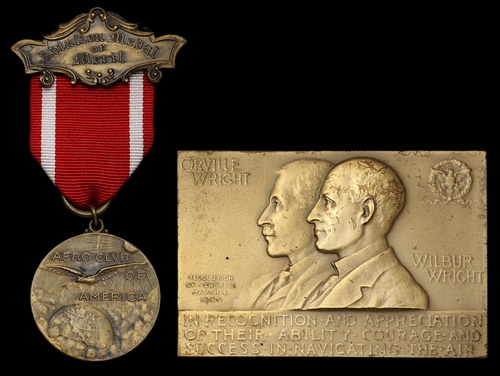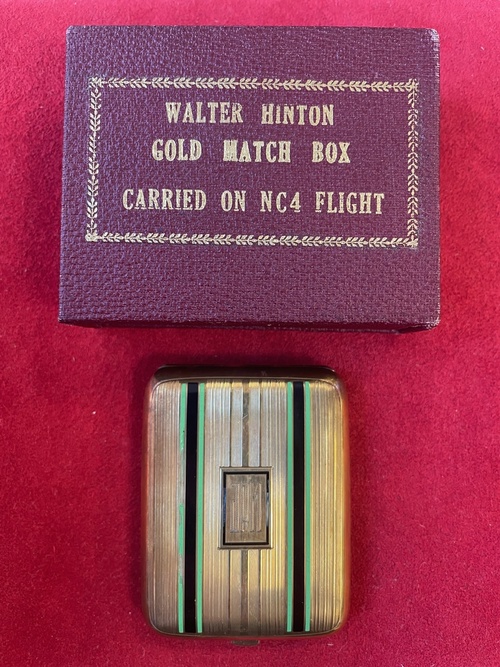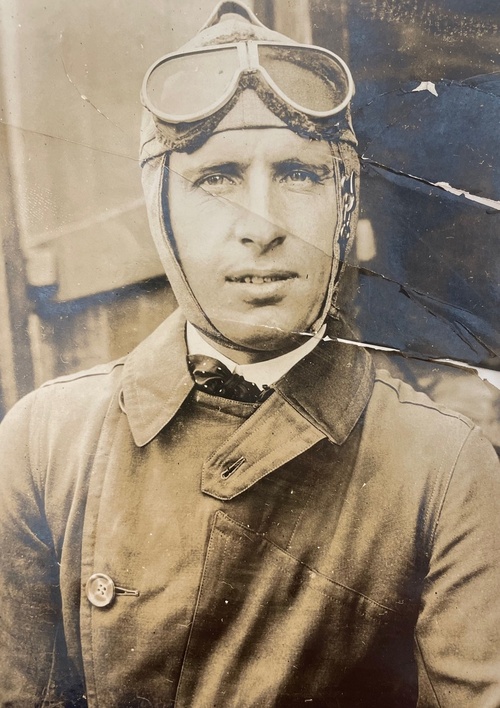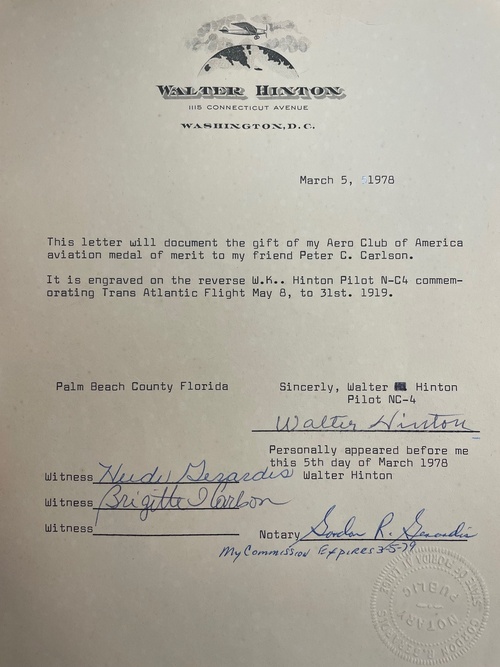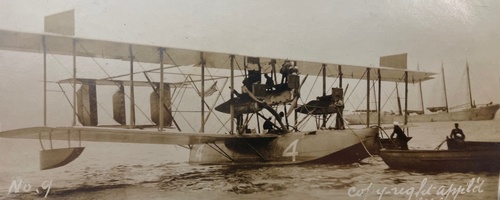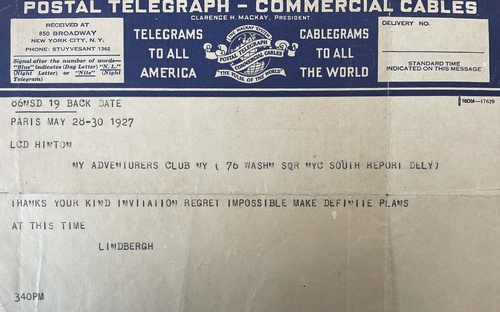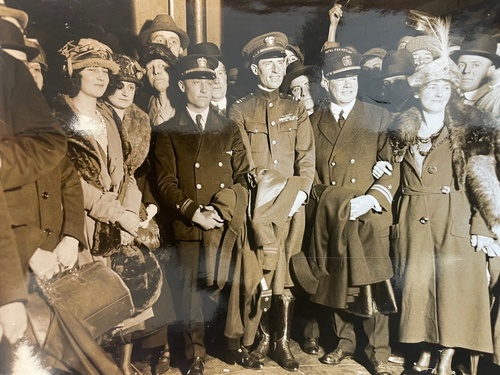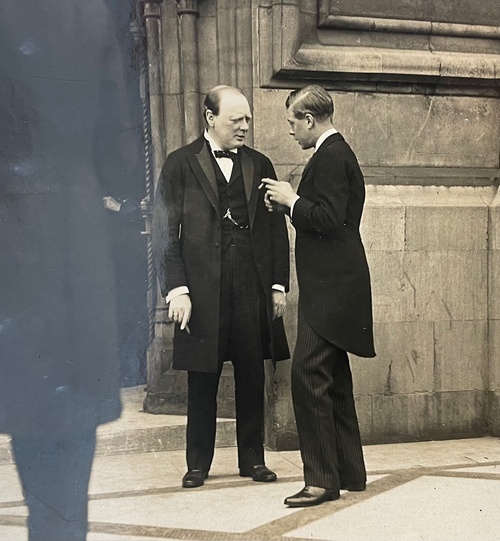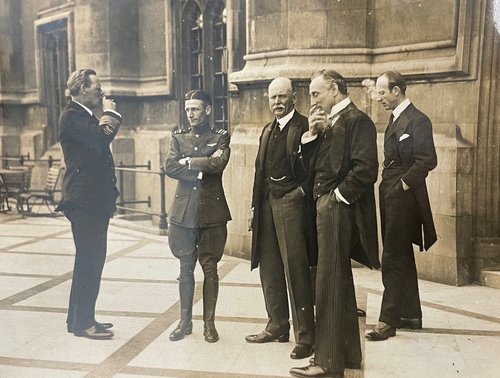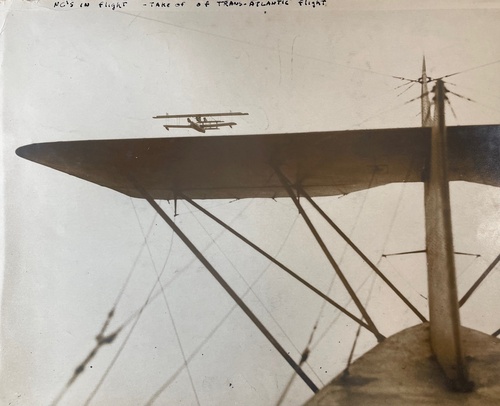Auction: 25001 - Orders, Decorations and Medals
Lot: 137
'On Tuesday May 27th, the crew of the NC-4 was up before dawn. The engines and radio was checked out and on the signal from Read, Elmer Stone advanced the throttles and the big flying boat lifted off in the early morning for Lisbon Portugal. Another chain of destroyers extended between the Azores and Lisbon. The weather was good and as the NC-4 passed over each destroyer the ship radioed a message of her passage to the base ship Melville at Ponta Delagada and the cruiser Rochester in Lisbon who in turn reported to the Navy Department in Washington. At 19:30 the flashing light from the Coba da Roca lighthouse was spotted and the NC-4 passed over the coastline. The big aircraft turned southward toward the Tagus estuary and Lisbon. At 20:01 on May 27, 1919, the NC-4s keel sliced into the waters of the Tagus. The welcome was tumultuous. A transatlantic flight, the first one in the history of the world, was an accomplished fact!
Early in the morning of 30 May the NC-4 departed Lisbon for Plymouth England. The NC-4 sat down in the Mondego River to investigate an overheating engine. The radiator had developed a leak and was repaired but because of a low tide condition it became too late in the day to take off and reach Plymouth before dark so Read proceeded to Ferrol in northern Spain to spend the night. They were back in the air the next morning and as they approached Plymouth a formation of Royal Air Force seaplanes escorted the NC-4 into the harbour. A British warship fired a 21 gun salute as the NC-4 circled. The Lord Mayor of Plymouth received Commander Read and his crew and from Plymouth they went to London where they were decorated by the King of England. President Wilson, who was at the Peace Conference in Paris, sent for them, congratulated them for their outstanding achievement and introduced them to all present…'
The triumphant closing stages of the NC-4's pioneering trans-Atlantic flight in May 1919; the U.S. Coast Guard's 'Aviation History' website refers.
The important Aero Club of America Aviation Medal of Merit, Artefacts and Archive appertaining to Walter T. Hinton, United States Navy, who co-piloted Curtiss Flying Boat 'NC-4' in the first ever trans-Atlantic flight in May 1919, a pioneering achievement for which he was awarded the Navy Cross and later the Congressional Gold Medal
(i)
Aero Club of America, Aviation Medal of Merit, bronze, obverse, an albatross over the globe, reverse officially engraved, 'W. K. Hinton, Pilot NC4, commemorating the Trans Atlantic Flight. May 8th to 31st 1919', 34mm., integral loop and ring suspension, complete with upper 'Aviation Medal of Merit' suspension device, and small length of original riband; accompanied by a signed declaration by Hinton, in which he gifts the award to a friend in 1978
(ii)
The recipient's 'match safe' vesta box, gold (marked 14K.), with black and green stripe enamel decoration and central monogram 'JPM', 47mm. by 60mm., contained in a felt-lined burgundy leather case, with lid inscription in gilt lettering, 'Walter Hinton Gold Match Box Carried on NC-4 Flight'; believed to have been another gift to Peter C. Carlson
(iii)
A commemorative plaque for Wilbur and Orville Wright's pioneering flight, bronze, rectangular, by Charles E. Barber and George T. Morgan, for the U.S. Mint, obverse, conjoined busts of the brothers with inscription, 'In recognition and Appreciation of Their Ability, Courage and Success in Navigating the Air', reverse, a winged female figure holding a torch, with upper inscription, 'Shall Mount Up with Wings as Eagles', 55mm. by 80mm., somewhat discoloured by old lacquer
(iv)
American Aeronautical Society, bronze disc commemorating the First Annual Dinner, New York, 27 April 1911, 40mm., together with a small medallet with aircraft in flight and reverse inscription, '1954 3rd', on a black riband
(v)
A significant photographic archive (approximately 70 images), of aircraft, personnel and related subject matter, covering Haiti 1915, Mexico 1917, the crash of the NC-2 at Atlantic City in 1919, the take-off and in-flight of the trans-Atlantic flight, subsequent scenes from Lisbon and London - the latter including a photograph of the Prince of Wales and Winston Churchill - his triumphant return to the U.S.A., thence his Long Island to Hudson Bay flight in 1920, U.S.A. to Brazil flight in 1922-23 and take-off from the Amazon in 1925, together with images of Charles Lindbergh and Eddie Rickenbacker.
(vi)
A postal telegraph from Charles Lindbergh in New York, sent to Hinton in Paris in May 1919, 'Thanks for your kind invitation. Regret impossible to make definitive plans at this time'; together with a quantity of Hinton's calling cards and home stationery. (Lot)
Walter T. Hinton was born in Pleasant Township, Van Wert County, Ohio on 10 November 1888, where he was raised on a farmstead. An adventurous soul, he was motivated by a poster urging young men to 'Join the Navy and See the World' and did just that, entering the United States Navy in February 1908 and seeing action at the occupation of Veracruz in Mexico in 1914.
But it was in naval aviation that he was to make his mark, having become one of the first enlisted men gain a place at the Naval Air Station in Pensacola, Florida. He became an instructor on gaining his 'Wings', one of his pupil pilots being Richard E. Byrd, afterwards the famous polar aviator.
Of his subsequent exploits as co-pilot with Elmer Stone of the Curtiss NC-4's trail blazing trans-Atlantic crossing in May 1919, much has been written, including The Flying Firsts of Walter Hinton, by Benjamin J. Burns. In addition, numerous website sources bear testament to the epic nature of the flight, a particularly detailed account appearing on the U.S. Coast Guard's 'Aviation History' site:
https://cgaviationhistory.org/1919-nc-4-transatlantic-flight/
Of the three flying boats that set out from Rockaway Beach, New York on 8 May 1919, only NC-4 made it safely to Lisbon, via ports of call in Nova Scotia and the Azores in a journey lasting 19 days. The subject of rapturous receptions over the coming weeks - not just in Lisbon, but in London and Paris too - Hinton and his crew enjoyed further accolades by way of reward, among them honours bestowed by the Portuguese and British governments, in addition to those presented them on returning to America; Hinton's Navy Cross was later surpassed by a Congressional Gold Medal awarded him in 1929.
During the 1920s, he continued his pioneering work, exploring the Arctic by balloon, including a wayward flight in Navy Balloon A-5598 from Rockaway Naval Air Station to Moose Factory, Ontario, a winter trip which ended with a month-long hike back to civilisation. He also made the first flight from North America to South America, where he explored the Amazon forest by hydroplane; his first attempt at that feat nearly ended in disaster, when he was compelled to take to the wing of his aircraft in shark infested waters off Cuba.
A noted speaker on aviation matters, Hinton was President and founder of the Aviation Institute of the U.S.A., and published a number of periodicals, including Pioneers in Aviation, Aviation Progress and Wings of Opportunity.
Retiring to Pompano Beach, Florida - where he delighted in sharing his memories with all and sundry - his glittering career was crowned by a supersonic flight in Concorde, when, as a special guest, the Atlantic crossing took less than four hours. After his death in 1981, his ashes were interred at Arlington National Cemetery.
Subject to 20% VAT on Buyer’s Premium. For more information please view Terms and Conditions for Buyers.
Estimate
£4,000 to £6,000
Starting price
£3200

